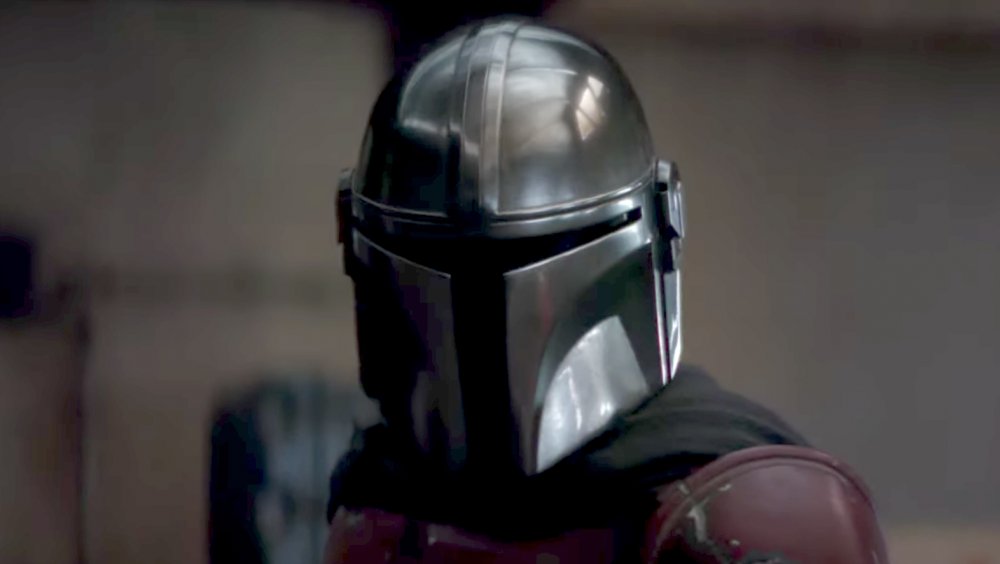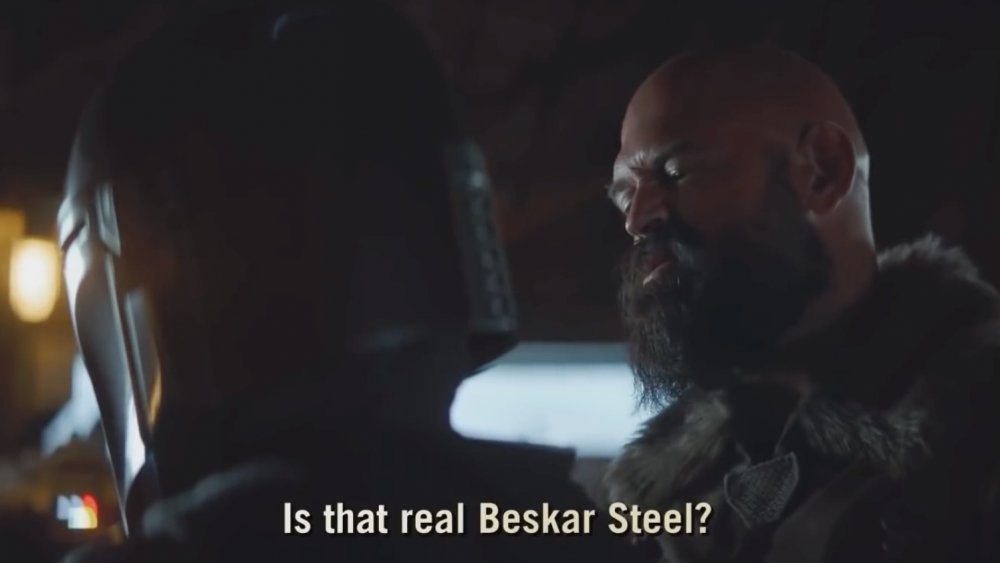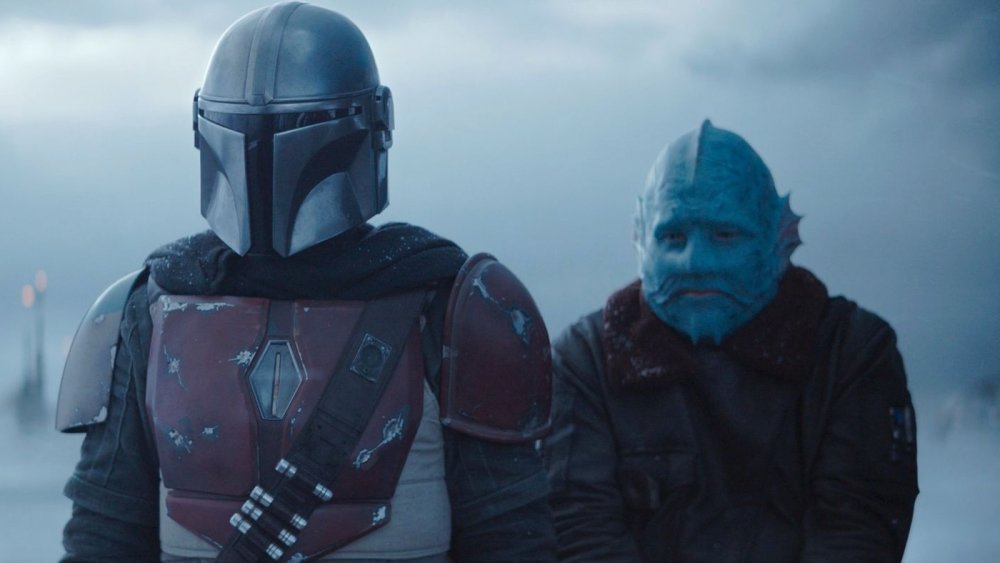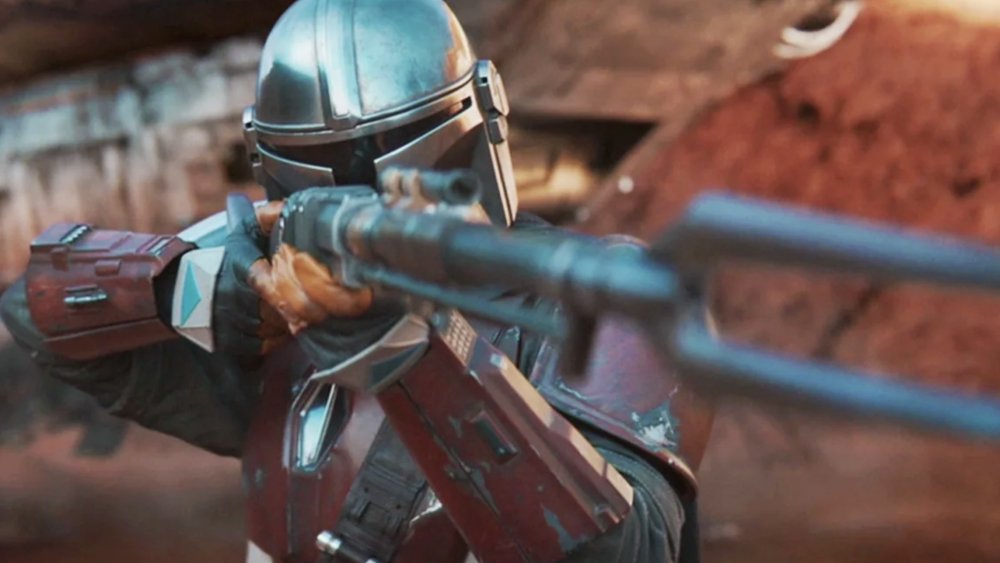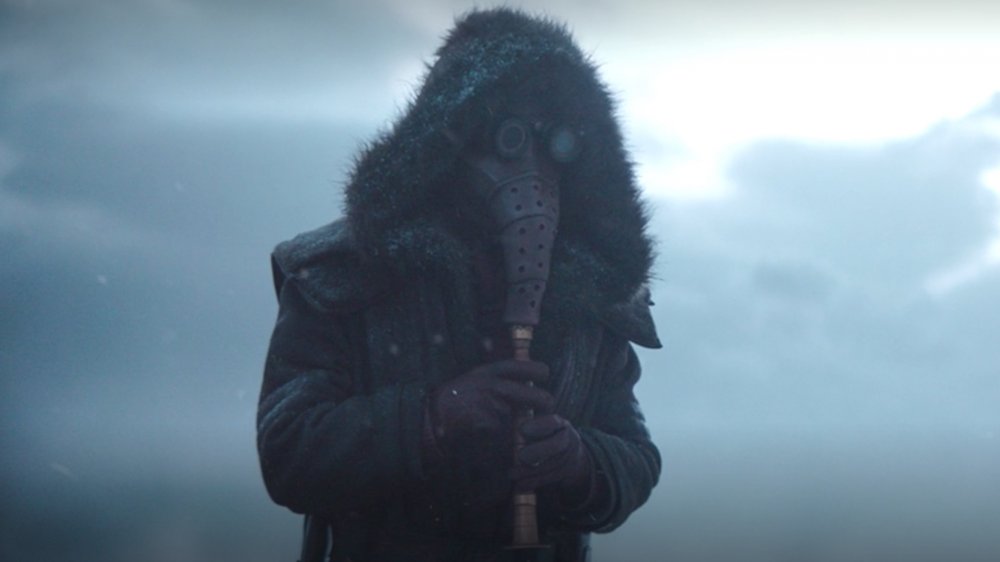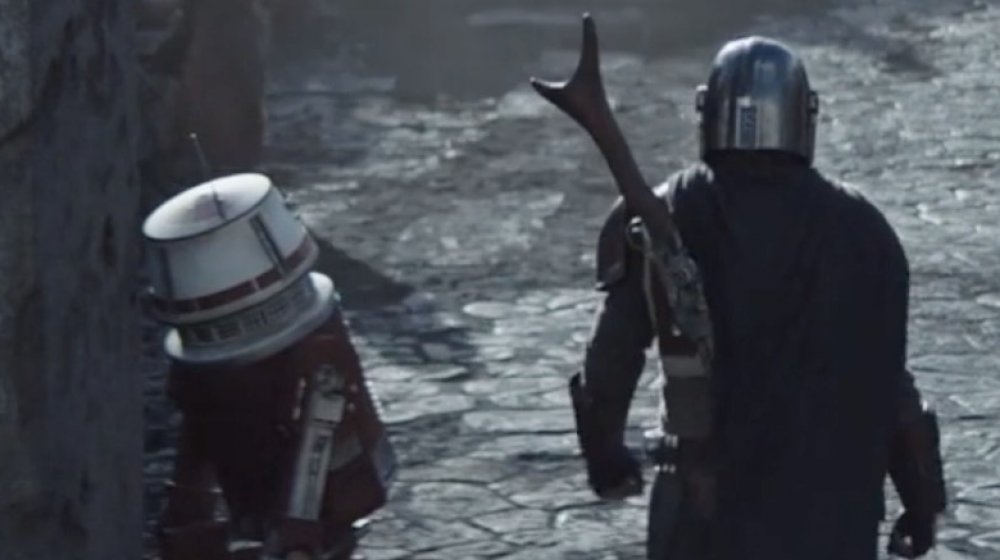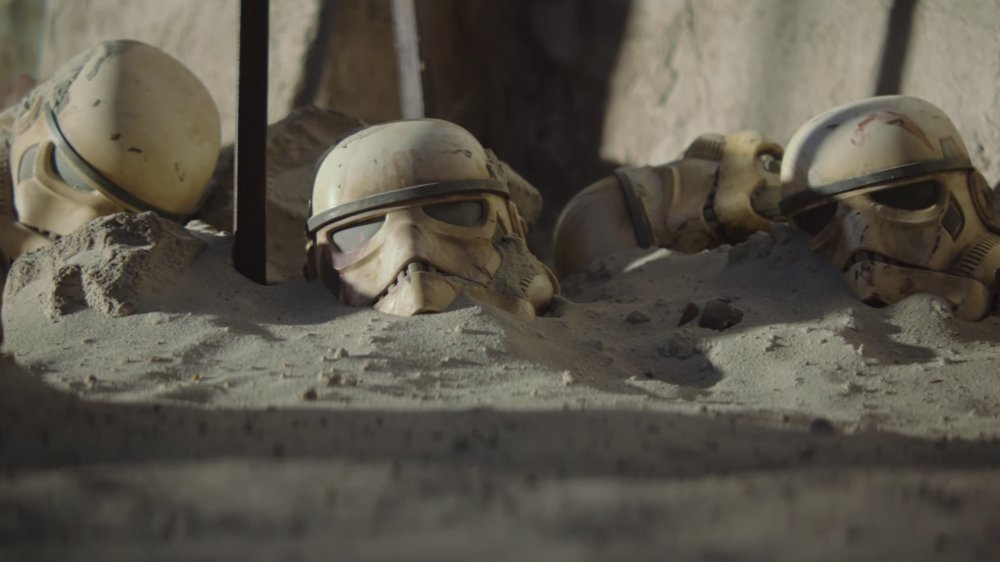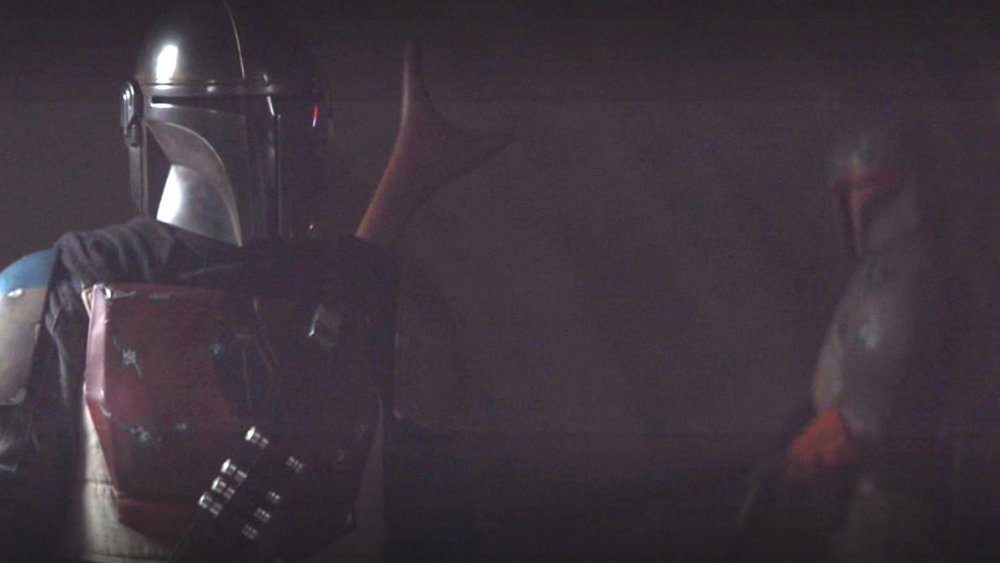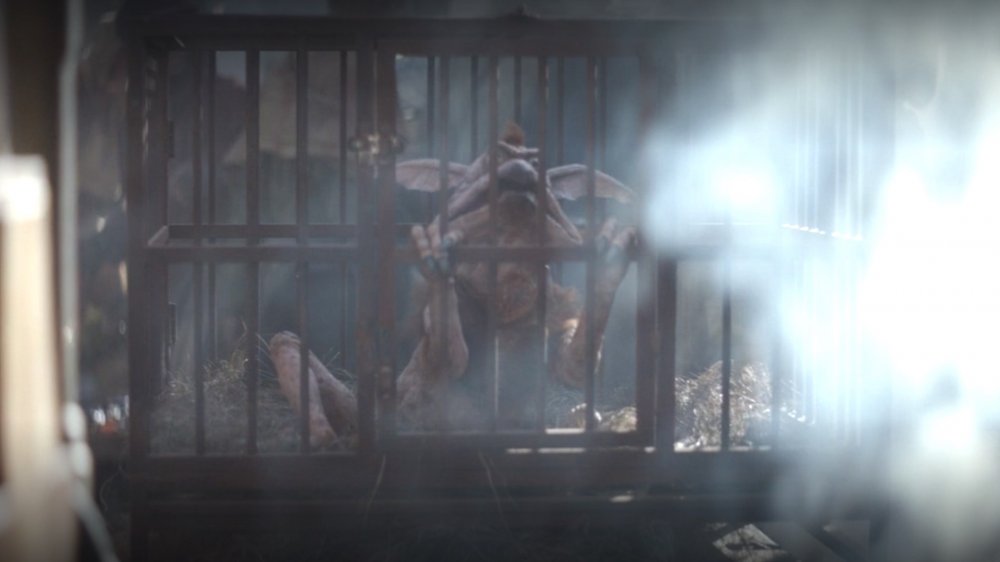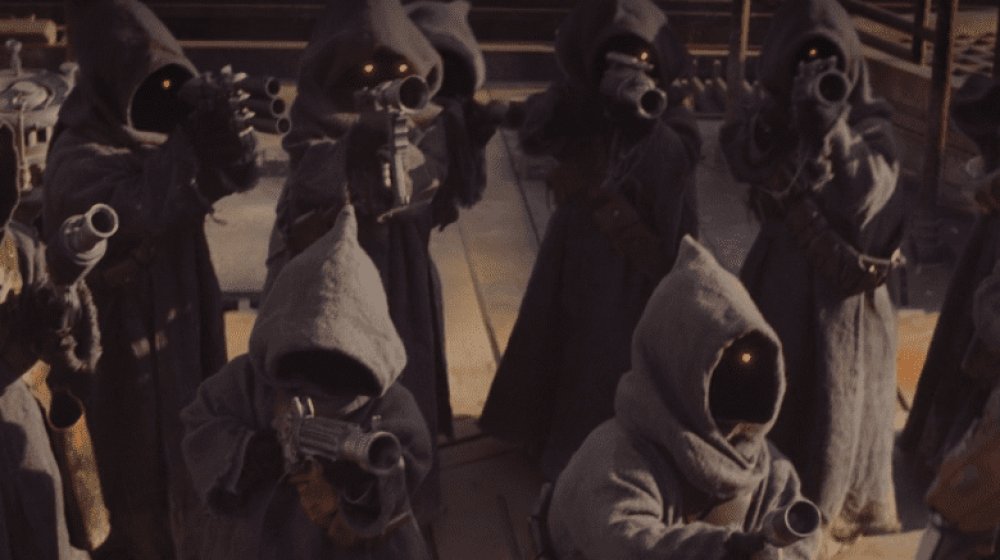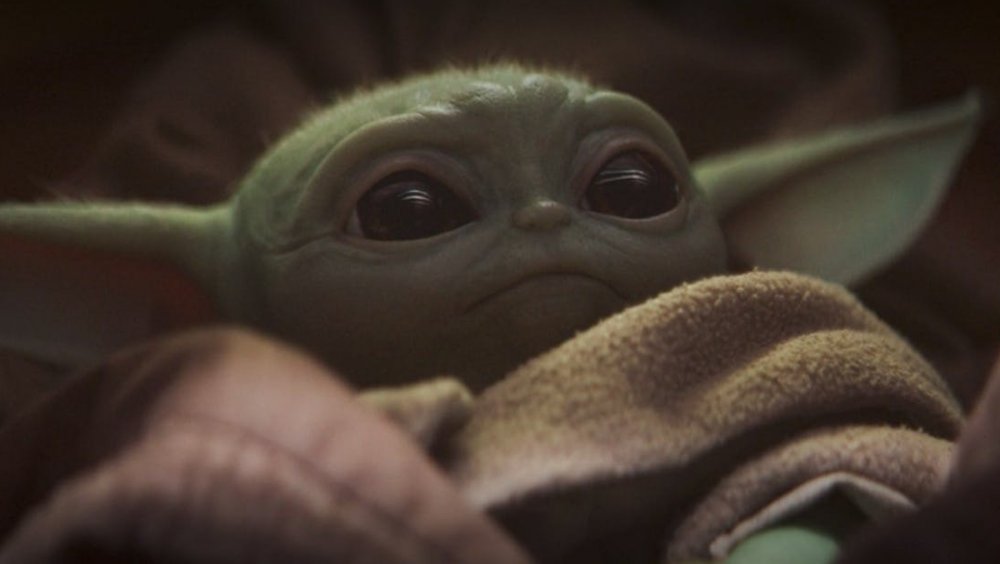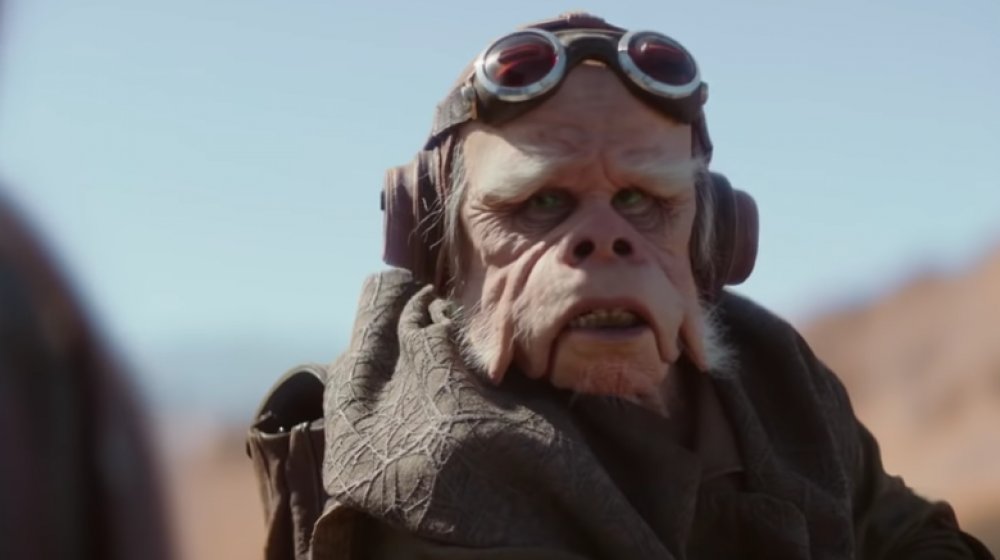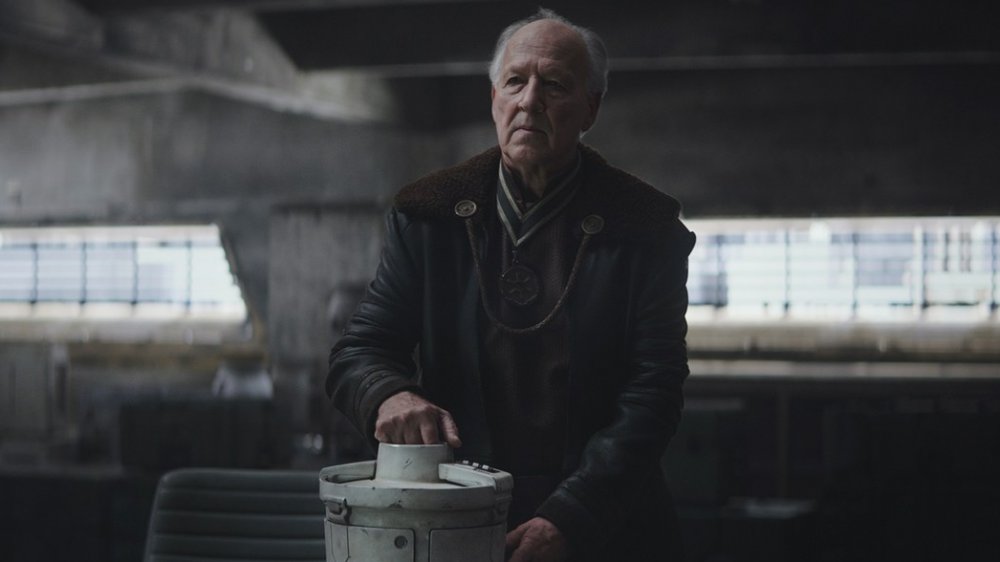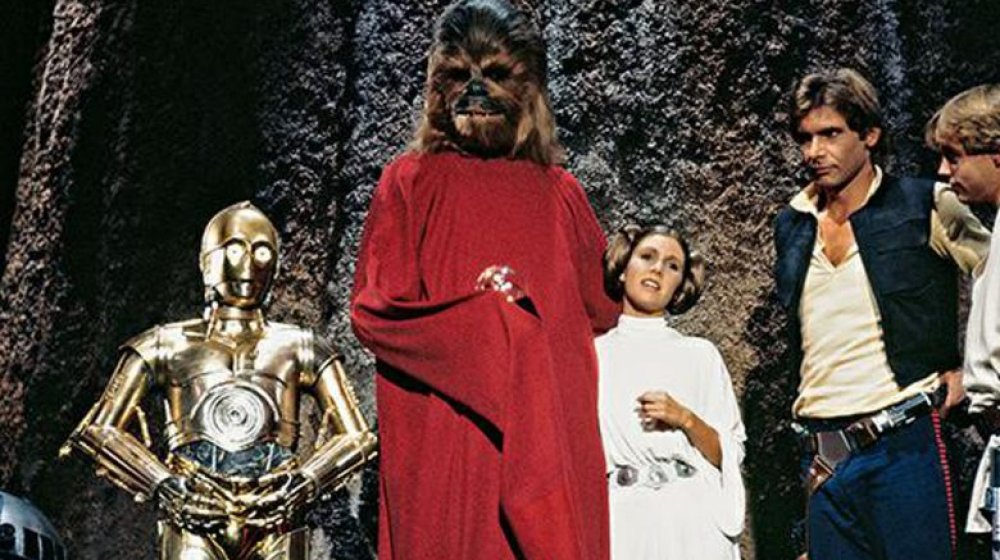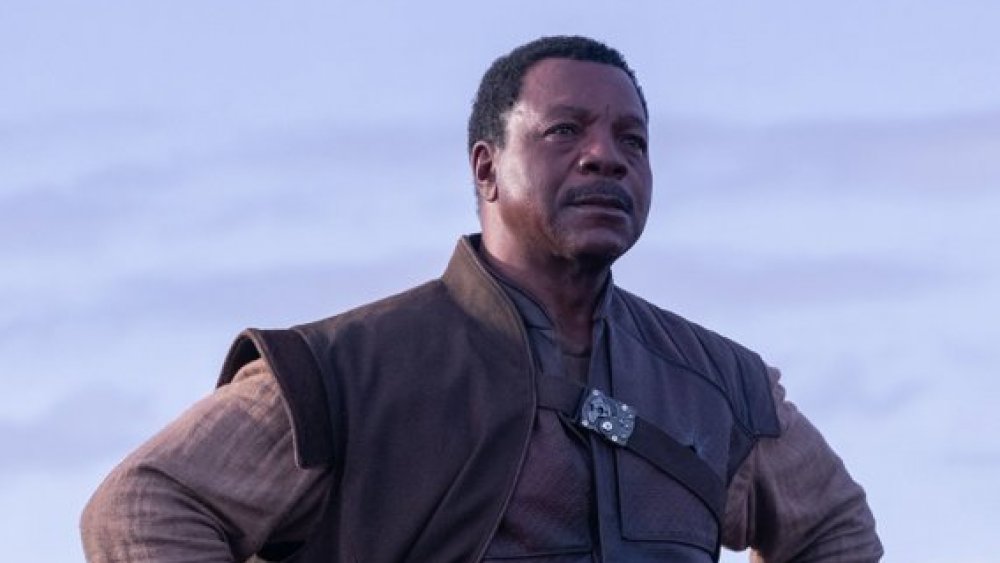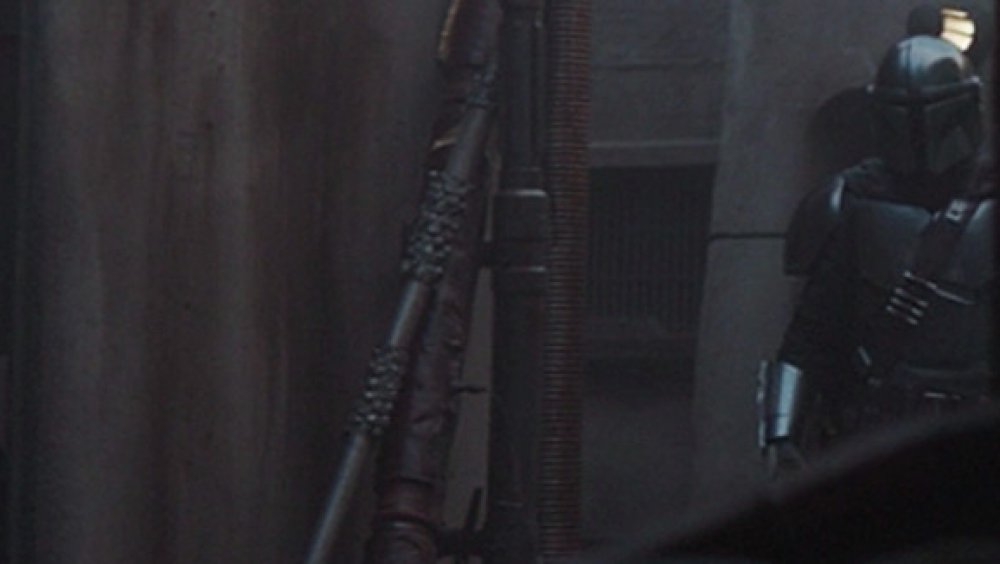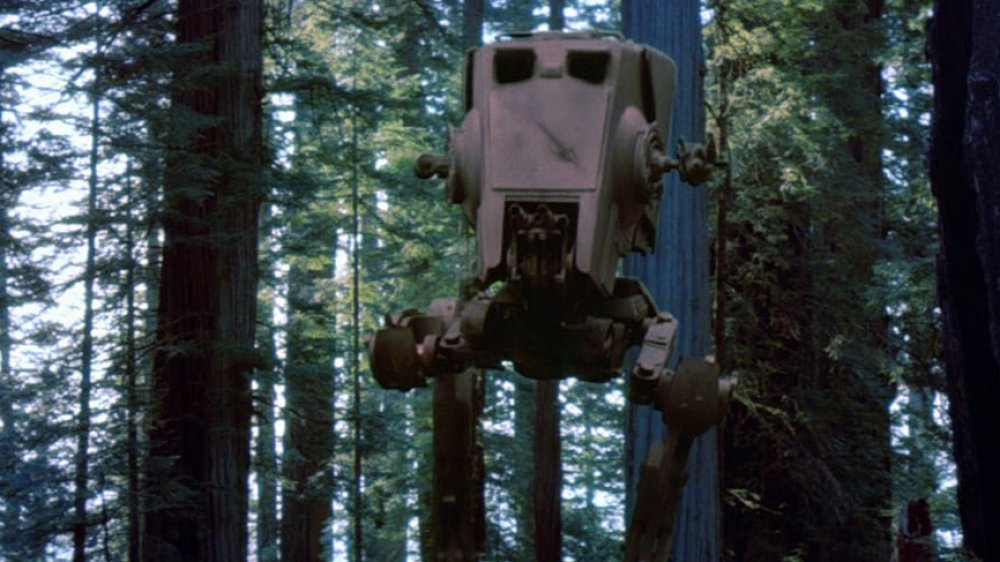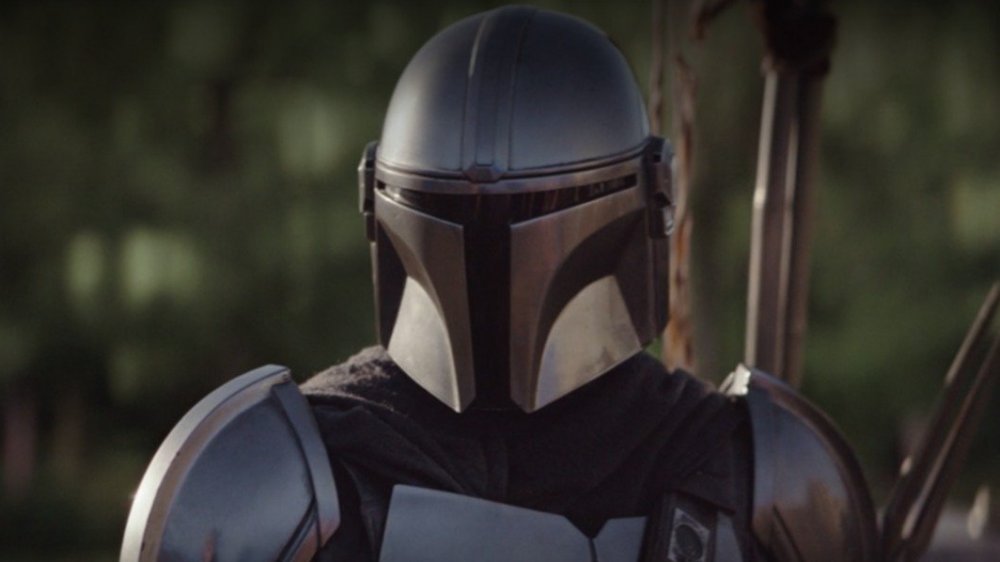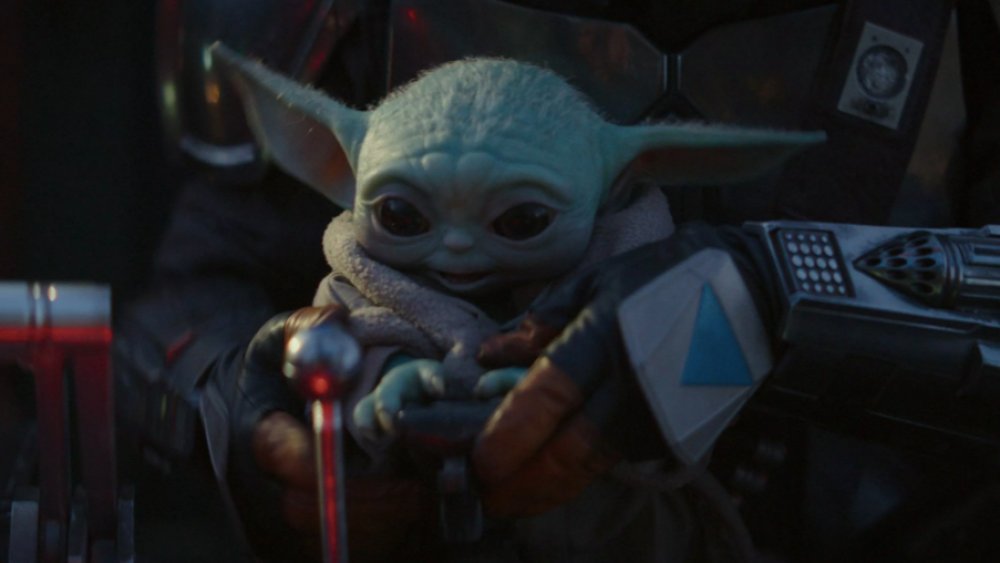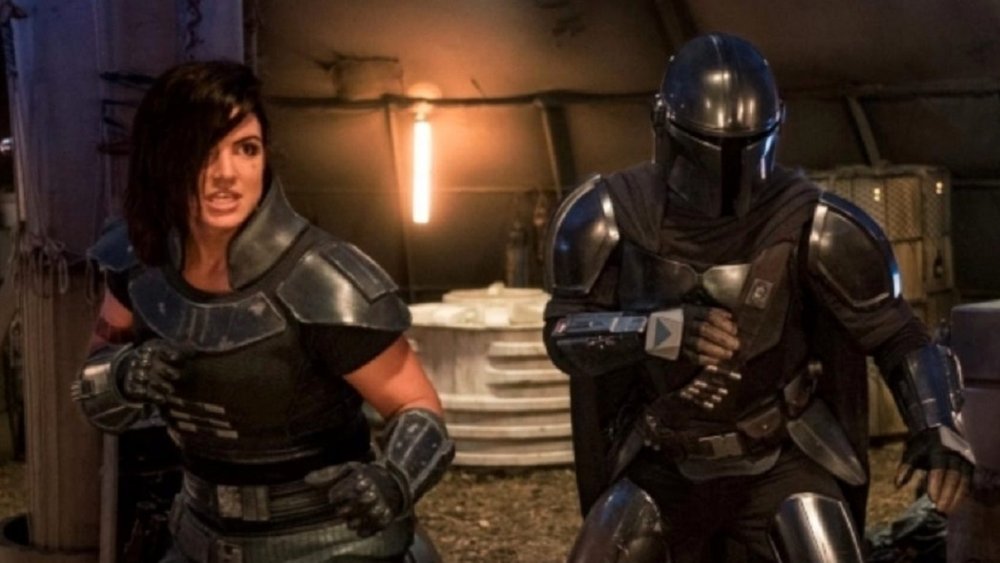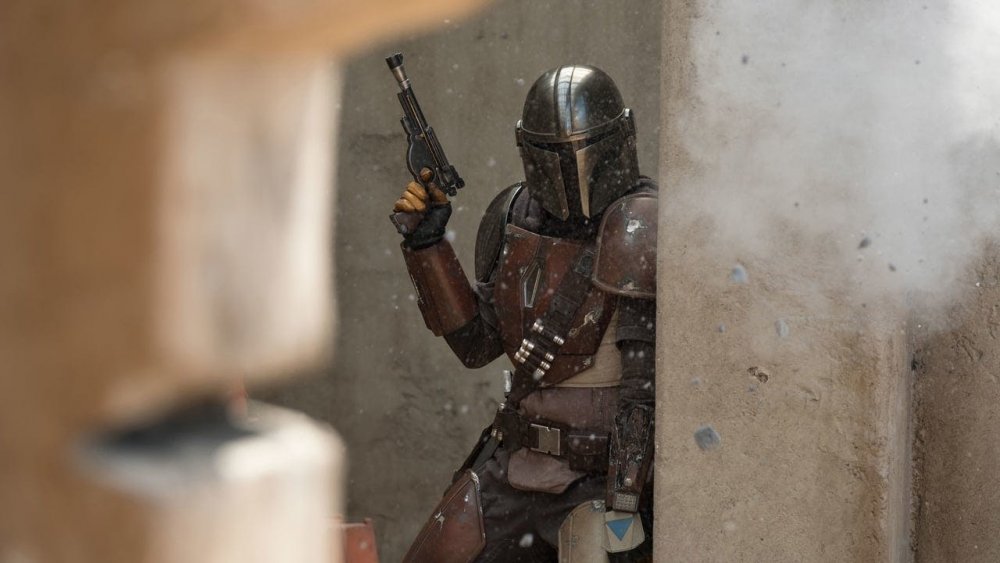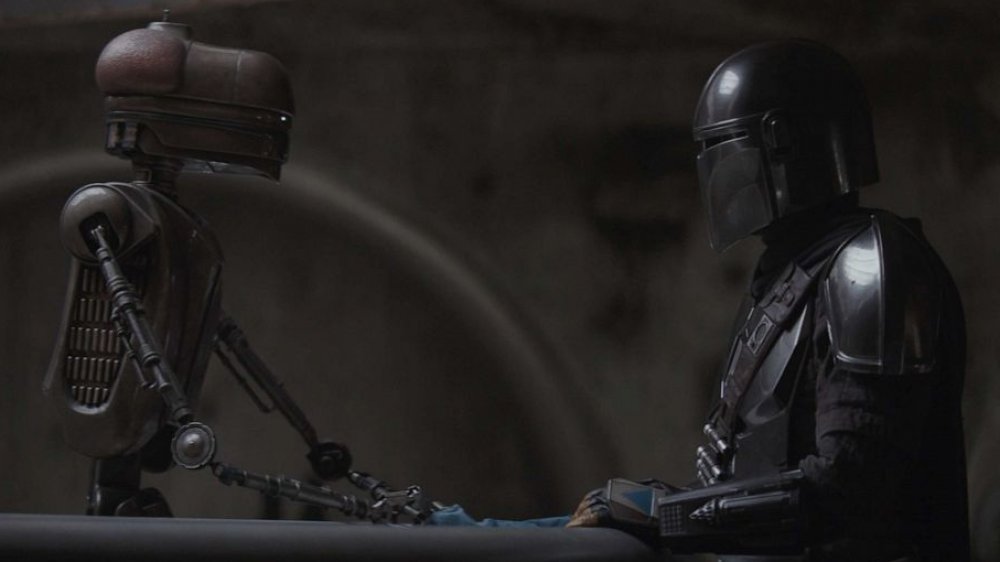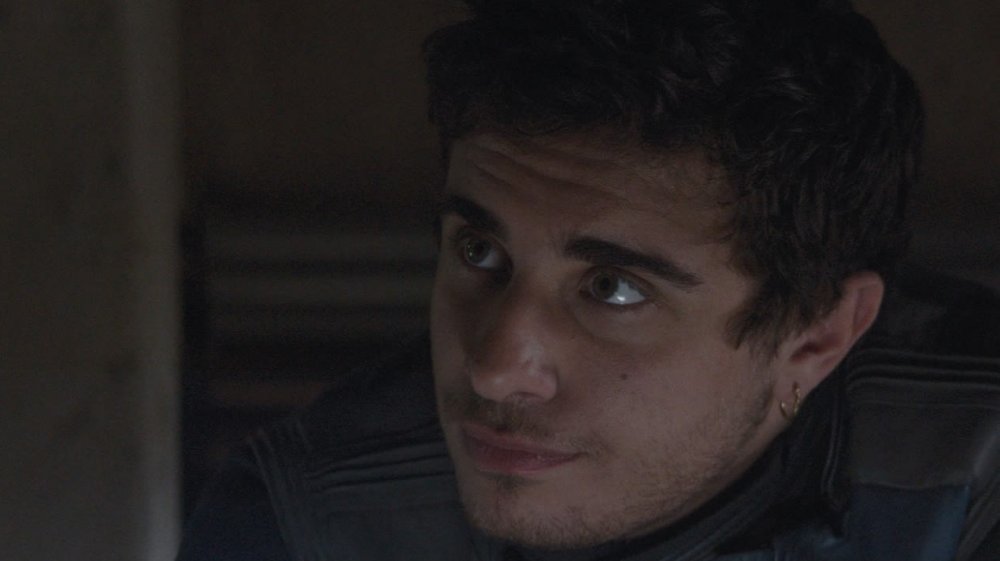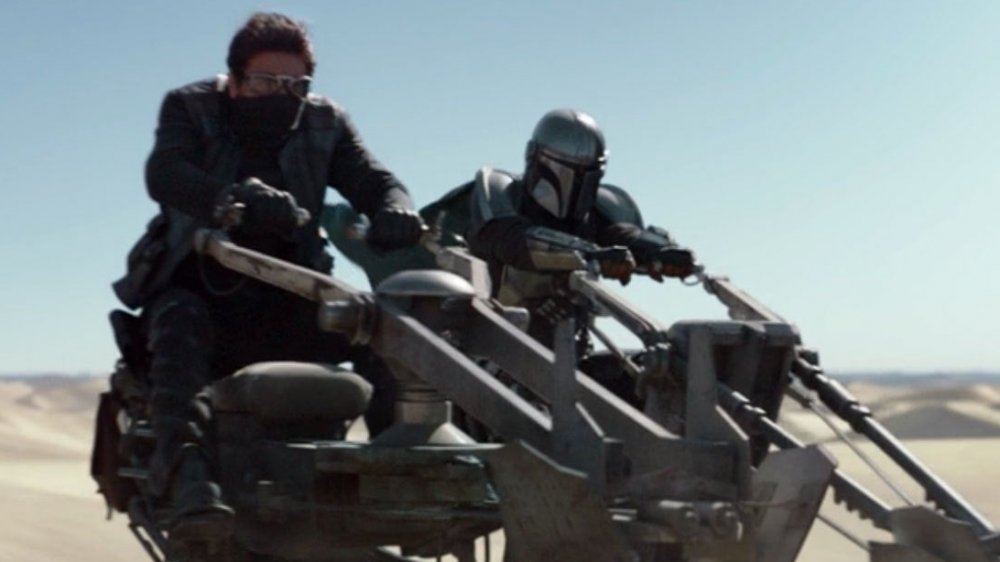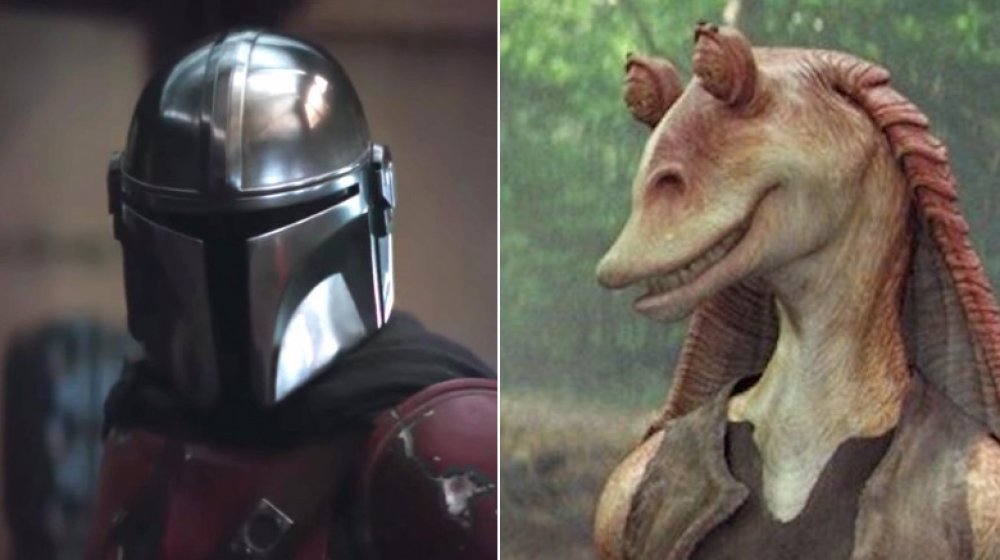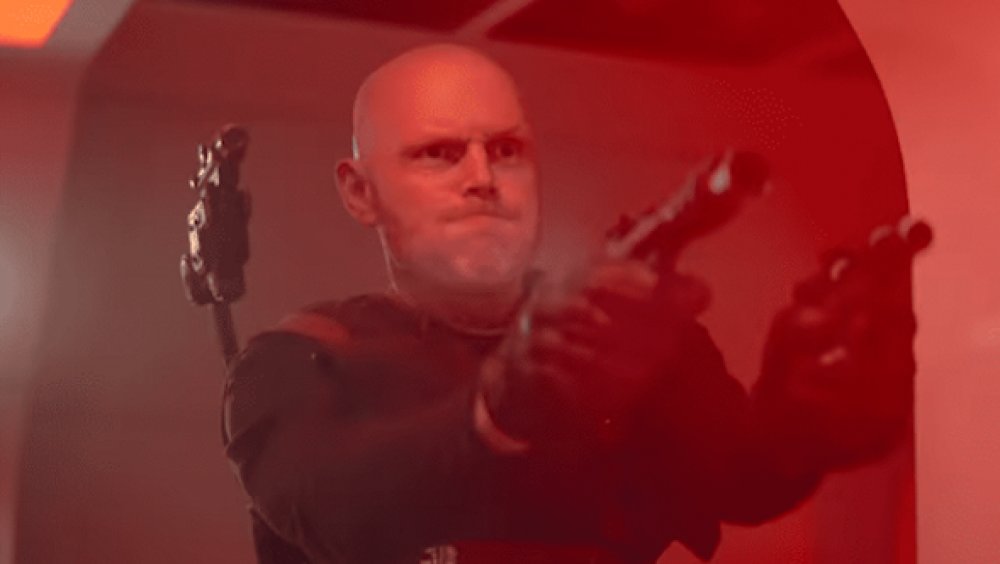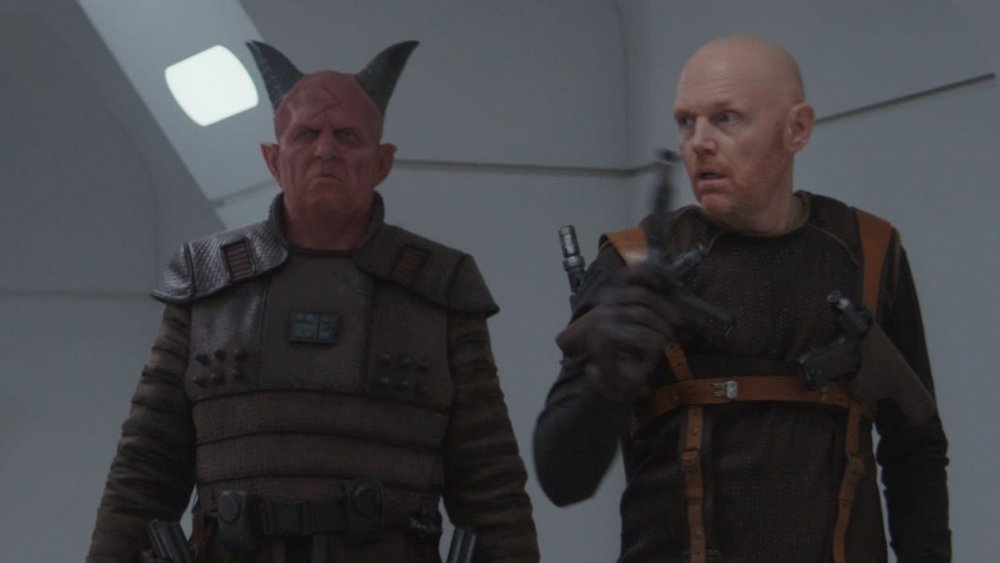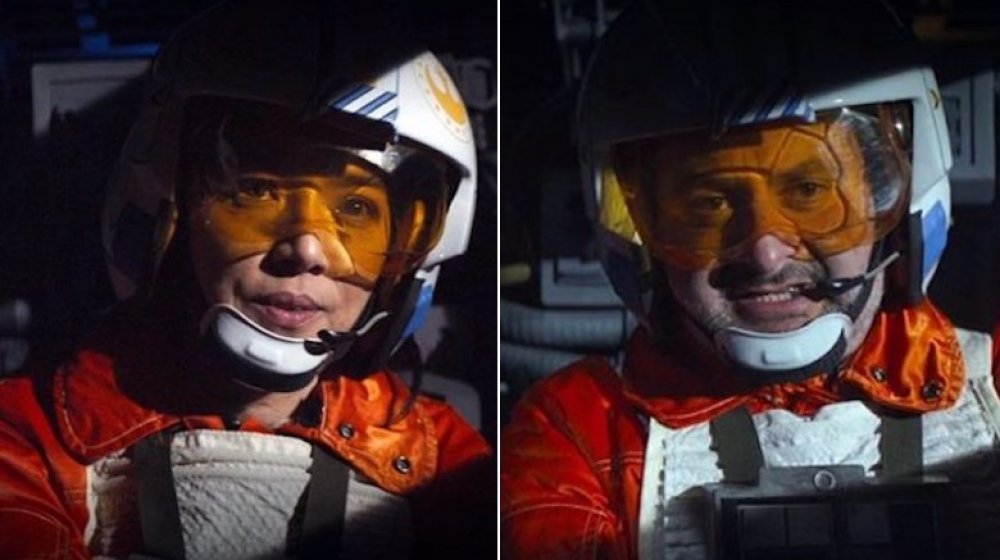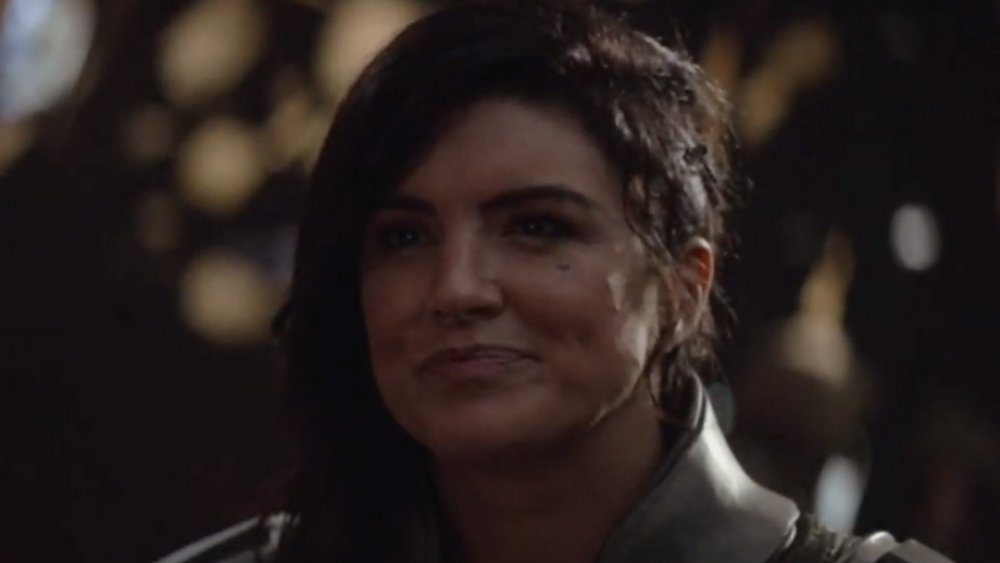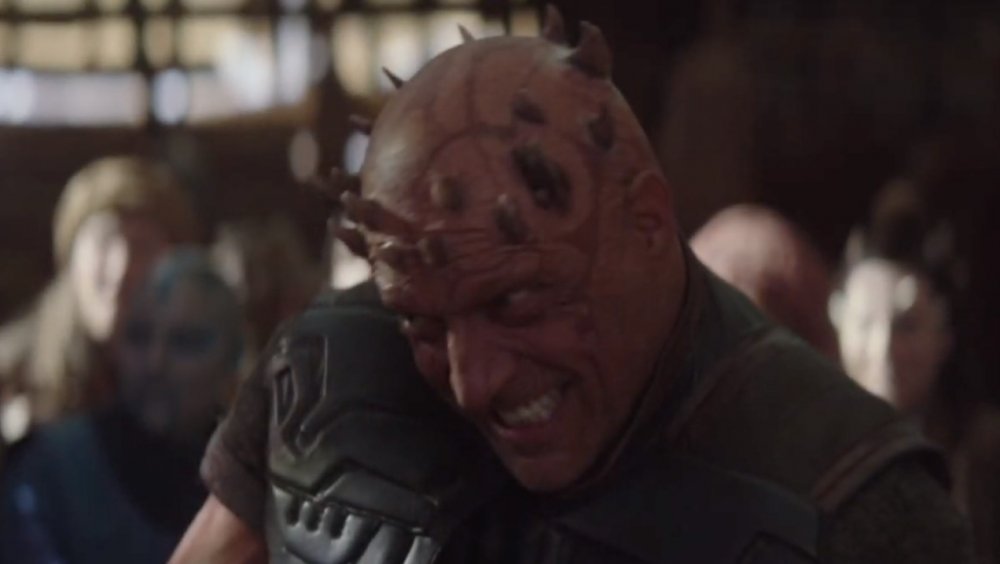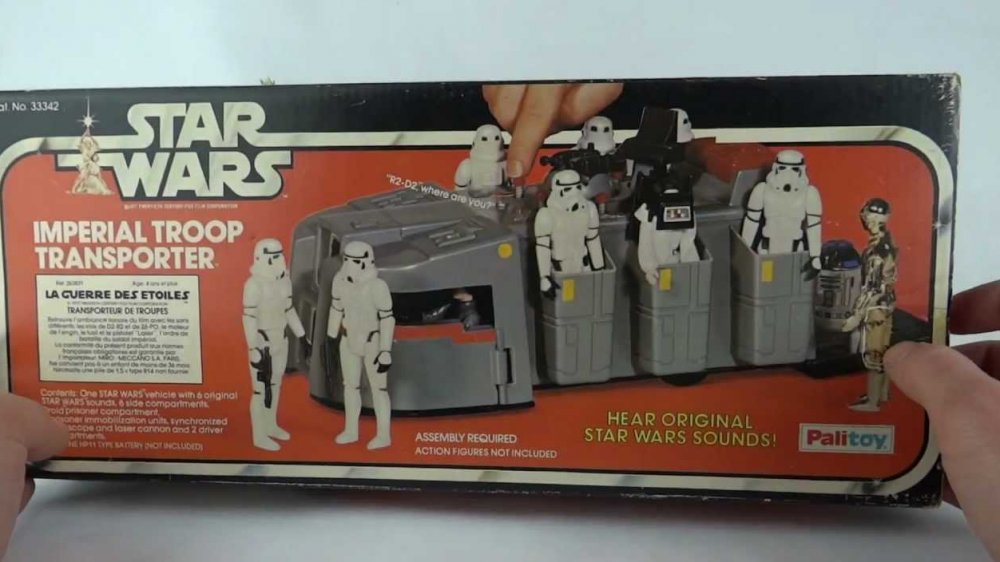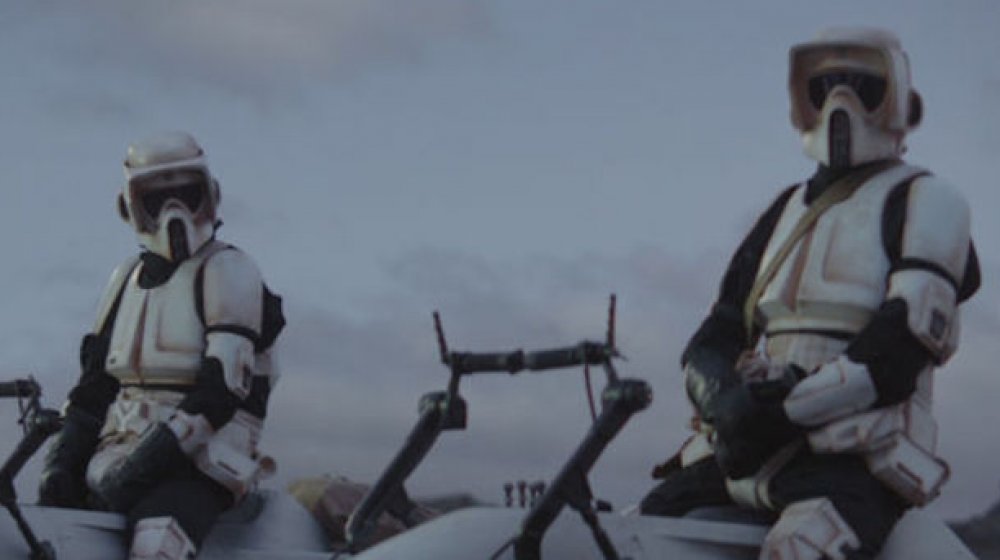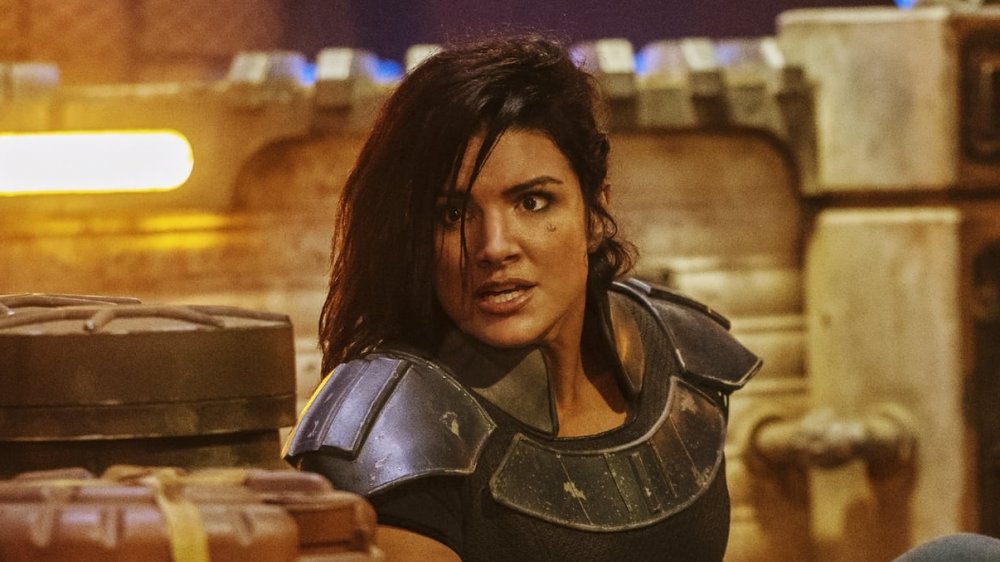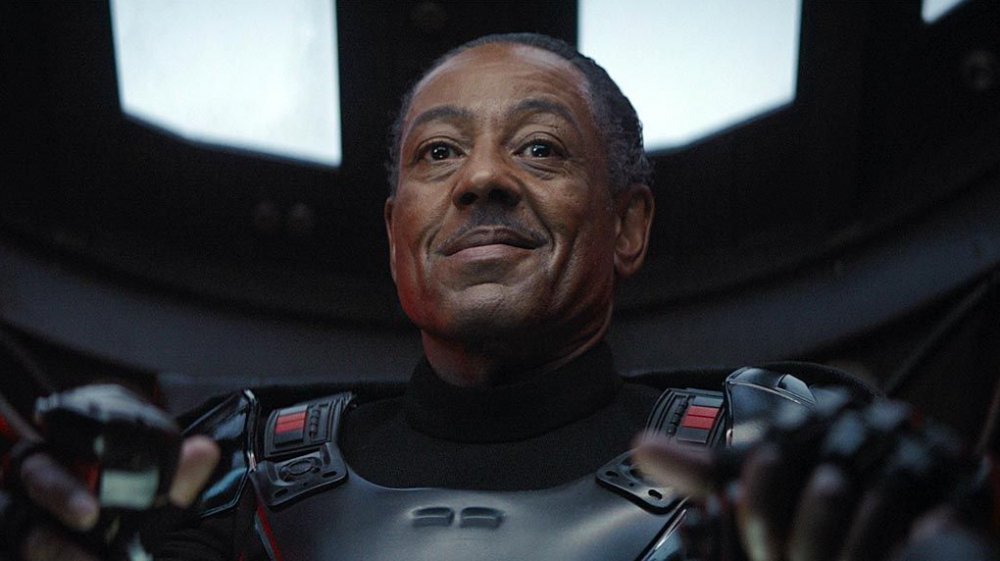Easter Eggs You Missed In The Mandalorian
Disney+ is a big deal. The promise of virtually every major movie and TV series ever made in a Disney-owned franchise is enough to entice subscribers, particularly the oodles of Star Wars content. All eight main movies — from A New Hope to The Last Jedi — were available at launch, as were Rogue One and the animated Clone Wars and Star Wars Resistance. But perhaps the most exciting offering: The Mandalorian, the first live-action Star Wars television series.
Pedro Pascal (Oberyn Martell on Game of Thrones) stars in the title role, a loner of a gunman and bounty hunter from the planet Mandalore. Showrunner and creator Jon Favreau made this series, clearly a flagship program for Disney+, with the production values and watchability of a Star Wars feature film. One other thing it has in common with Star Wars movies: lots of subtle references and callbacks to other Star Wars media. Here are some Easter eggs that even the sharpest-eyed Star Wars fans might have missed in The Mandalorian.
It's just some Jabba-jabber
The Mandalorian takes place after the events of the original Star Wars trilogy (the one that ends with Return of the Jedi) and before the events of the final trilogy (the one that starts with The Force Awakens). There are lot of different races from a lot of different planets interacting in the first episode, and many of them use their own distinct language. In a bar scene at the top of the first episode of The Mandalorian, a fearsome-looking man with an unruly beard beats up on a blue-skinned Mythrol (Saturday Night Live alum Horatio Sanz), the charge our protagonist bounty hunter is after.
"Look at his glands. I bet we could sell them at the port!" subtitles tell the audience the bully says in an alien language. This guy tries to pick a fight with the Mandalorian when he arrives, asking of his armor, "Is that real Beskar steel?" The language he's speaking is Huttese, the language of the Hutts, a Star Wars race made most famous by Jabba the Hutt. (This character doesn't much look like a Hutt, however, as he's a humanoid.)
Happy Life Day!
After the Mandaloian captures and carts off the Mythrol to collect the price on his head in episode one — narrowly escaping an attack by a hungry ice beast — the prisoner makes small talk with the stoic, silent bounty hunter back on his ship. "Yeah, I was hoping to be free for Life Day, get home to the family," he says, cutting himself off when he discovers the Mandalorian's other bounties frozen in carbonite (just like Han Solo in The Empire Strikes Back).
What's Life Day? It's the Star Wars universe's equivalent of Christmas — a time for celebrating and relaxing with loved ones. It was first introduced in The Star Wars Holiday Special, an infamous 1978 television variety show. It follows Chewbacca's family as they watch futuristic TV and wait for him to arrive for Life Day. The special ends with Princess Leia (Carrie Fisher) singing a Life Day carol.
The Mandalorian's familiar weapons
Life Day isn't the only Mandalorian callback to that unloved Star Wars Holiday Special. We also see the title character sporting a distinctive weapon that should be familiar to longtime fans of a galaxy far, far away — specifically, the pronged rifle he wields at one point during the show. It's a cool-looking apparatus with a long past: in Boba Fett's first-ever appearance, made during an animated sequence during the Holiday Special, he's packing the same weapon (known as an Amban phase-pulse blaster if you really want to talk specifics with the hardcore Star Wars fan in your life). It likely doesn't mean much as far as a connection to Fett is concerned, but it's a nifty nod to Star Wars lore that proves showrunner Jon Favreau is deeply invested in layering fan service into this series.
Episode two delivers even more vaguely familiar entries in the Mandalorian's arsenal. During his battle with a Mud Horn, he fires a small flamethrower mounted on his arm. Specifically, that's a ZX miniature flame projector, and it's apparently standard issue bounty hunter gear, as both Jango Fett and Boba Fett have been depicted with one in various Star Wars media.
The Mandalorian's nosy dispatcher
The first episode of The Mandalorian is filled with enough alien dudes and monsters to satisfy any amateur xenobiologist. While it'd take too long to catalogue every single alien who appears in the show, it's certainly worth pointing out one of the most surprising appearances of the episode.
Early on, when the Mandalorian and his fin-faced bounty are booking passage back to his ship, the Razorcrest, they encounter an alien hidden behind a pair of goggles and a long snout. He plays a killer flute, and we never learn his name, but he should've been instantly recognizable to any detail-oriented Star Wars fan. This fellow was a Kubaz, an alien species who's only shown up one other time over the course of the Star Wars saga. Cast your mind back to A New Hope — specifically the scene shortly after Luke and Obi-Wan meet Han Solo and Chewbacca. In the alleyways of Mos Eisley, a Kubaz named Garindan contacts the Imperial Stormtroopers patrolling the streets to let them know that he's found the droids they're looking for.
These are the droids you're looking for
If it's a Star Wars property, you can be guaranteed that it's going to be swimming in robots, or, as they're referred to in the franchise nomenclature, "droids." The Mandalorian is full of bleeping, blooping droids in the foreground and background, doing their jobs and staying out of the way of the humanoid characters. In one scene in the first episode, the Mandalorian walks through a marketplace. One of the objects he walks by is some kind of red and white R5 droid. It looks an awful lot like that red and white R5-D4 drone from Star Wars: A New Hope, the one with an explosively "bad motivator." Another R5 model appears later, during Chapter 5, in the Mos Eisley cantina. Given the close proximity to Luke's old farmstead, that one could very well be the same droid.
When the Mandalorian arrives at the fortified headquarters of "The Client," he's greeted by a round, red-light equipped droid tasked with security and gatekeeping. Why, that looks (and sounds) just like the security droid Jabba the Hutt used in Return of the Jedi, installed on the front gate of his Tatooine palace to keep out the riff-raff.
It's hard out here for a stormtrooper
The Mandalorian is set after Return of the Jedi, which means that the all the living beings on the planets caught up in the wars between the Empire and the Republic are trying to rebuild their lives and scrape by in a post-war society. This time period in the Star Wars canon is akin to the post-Civil War Reconstruction era in the American South, or a Marshall Plan-enabled Europe rebuilding after World War II.
In The Mandalorian, times seem to be especially tough for the "losers" of these star wars — those who associated with and worked for the Empire, before its fall and defeat. A man initially known only as "The Client" (portrayed by famed film auteur Werner Herzog) is an old Empire guy, and he surrounds himself with those familiar white-armored stormtroopers. They're still formidable looking, but they've fallen on hard times since the end of the Empire — reflected by the fact that their outfits are well-worn, a bit dirty, and even cracked in some parts.
Mandalorians
Forever masked bounty hunter Boba Fett is one of the most treasured characters in all of Star Wars... but he isn't a Mandalorian, he isn't the Mandalorian, and he isn't what The Mandalorian is all about. Instead, the show appears poised to teach casual Star Wars fans more about the Mandalorians than any other currently canonical media. We don't learn much in the first episode, but our protagonist does venture into some sort of forge in order to fortify his defenses. Carrying a slab of Beskar steel that he acquired from "The Client," he descends into an area where we see numerous other Mandalorians — including one shadowy figure in the background who even looks suspiciously like the supposedly deceased Boba Fett.
It's in this scene, when the Mandalorian is having a new shoulder pauldron made from the steel, that we catch brief glimpses of his past; specifically, the attack that orphaned him as a boy and left him a "foundling," or Mandalorian orphan. The forger who makes his new pauldron mentions that the leftover scrap will be used to sponsor other foundlings — the audience's first clue that in addition to being a fearsome bounty hunter, this character may also be pursuing a nobler agenda.
The Mandalorian's handful of Crumbs
Until now, the Kowakian monkey-lizard has had just one primary place in live-action Star Wars canon: as the snickering, semi-malevolent pet of unsavory characters like Jabba the Hutt. They're mischievous, they're obnoxious, they seem well-suited for villainy... and they're apparently delicious.
Immediately after the Mandalorian gets his bounty assignment from "The Client," he walks through the marketplace of a desolate-looking little town where shamed Imperial officers, stormtroopers, Mandalorian tribes, and probably many other ne'er-do-wells can hide without anyone batting an eyestalk. While the town is packed familiar-looking weirdos, one alien species stands out: the Kowakian monkey-lizard. Sucks for him, too, because he's being spit-roasted while his buddy looks on horrified from a cage. It's a bit of a horrific sight, especially knowing that these animals from the planet Kowak are known to have a pretty well-developed sense of humor. Talented court jester, or crispy food cart snack? While everyone's favorite monkey-lizard, Salacious B. Crumb, escaped Jabba's insatiable hunger by having a special talent for being a goofball, these other Kowakian creatures weren't so lucky.
Disintegration station
In episode two of The Mandalorian, the one they call Mando is keeping "the asset" — a creature that appears to be some kind of adorable baby Yoda — safe throughout a treacherous and violent journey. This trip includes a run-in with Jawas, a race very recognizable to fans of the Star Wars films for their hooded cloaks and glowing eyes. The Mandalorian blasts any that get in his path, turning them into sheer nothingness as they poof away without a trace. Later on, Kuiil remarks to the Mandalorian that the creatures "really don't like you for some reason." Mando replies, "Well, I did disintegrate a few of them."
This calls back to a brief exchange in The Empire Strikes Back between Darth Vader and Boba Fett, in which the dark lord tells that other bounty hunter to bring back the crew of the Millennium Falcon. "I want them alive," he orders. "No disintegrations." In other words, these bounty hunters just love blasting their enemies into non-existence and will do so when given the chance.
Aw, he's using the Force!
While the full identity of "the asset" is not yet clear by the second episode of The Mandalorian, it's obvious to anyone with even a passing familiarity of Star Wars that it's a very young version of a creature like Yoda. While this thing is reportedly 50 years old, he's still baby-like in many ways, but at the same time, Yoda-like in others. To name one huge example, he can apparently use the Force. He employs the mind-over-matter device to lift a Mud Horn off the ground, not unlike that time in The Empire Strikes Back when Yoda thought real hard and lifted an X-wing right out of a swamp.
The Force takes many forms, including healing abilities, and this small, potential Yoda successor also has that power. The great Obi-Wan Kenobi was blessed with that particular quirk, which he used to help Luke recover in the original Star Wars. The little green one in The Mandalorian attempts to do the same for one of Mando's wounds. Later, in Chapter 7, the baby heals a far more serious injury sustained by Bounty Hunters' Guild head Greef Karga (Carl Weathers), displaying a heretofore unseen level of power that's astounding to everyone around him... and to the audience. Of course, The Rise of Skywalker, released the very same week as Chapter 7, sees Rey pulling off similar feats.
He's a working man
Kuiil — the Mandalorian's ally, friend, and lifesaver — is voiced by Oscar-nominated actor Nick Nolte, who brings his specific irascibility and world-weary style of acting to the loner Ugnaught. But really, Kuiil doesn't have to work alone if he doesn't want to.
See, after they've escaped a whole lot of trouble in the second episode of the series, Mando suggests making their relationship a bit more permanent. He offers Kuiil a well-paid spot on his crew, but Kuiil respectfully rejects it out of hand. "I am honored, but I have worked a lifetime to finally be free of servitude," he explains. And then he's gone. That's a weighty statement, but his reasoning can be traced back to The Empire Strikes Back. During a visit to Cloud City, Ugnaughts were depicted, ever so briefly, as the backbone of that civilization — the ones responsible for the hard labor.
In Chapter 7, Kuiil sheds a little more light on his own backstory, revealing that he once lived a life of indentured servitude to the Empire. Whether or not his life has intersected with those of Cloud City's Ugnaughts, this certainly lends even more weight to the value he places on his own freedom.
We all scream for... beskar
During the evacuation of Cloud City in The Empire Strikes Back, a random guy (later given the name Willrow Hood) runs into the frame, looking for a way out while desperately clutching a large piece of space-age technology under his arm. It's white, about the size of an ice cream maker, and is outfitted with a central cylinder like one would find in an ice cream maker, and okay, yes, that prop from a distant galaxy is, in fact, an ice cream maker.
Willrow Hood and his devotion to keeping an earthly appliance safe became a fan favorite bit of Star Wars lore, and his story was later given a canonical explanation: he worked for a mining company and he was protecting an object filled with sensitive information about the Rebel Alliance. Nearly 40 years after the release of Empire, the third episode of The Mandalorian provides a full and compelling explanation of the fated frozen treat machine.
The Mandalorian returns to the Client to hand over "The Asset" (America's newest sweetheart, "Baby Yoda") and to receive his promised reward: "a camtono of beskar," the precious, armor-worthy material favored by Mandalorians. Good on his word, the Client hands over that beskar in what looks like an ice cream maker. If it's good enough to keep everything from beskar steel to rebel secrets secure, it's clear that one of the most trusted devices in the Star Wars galaxy is the noble ice cream maker. Sorry — camtono.
Dreaming of a red Life Day
The third episode of The Mandalorian, "Chapter Three: The Sin," debuted on Disney+ just a few days before Thanksgiving 2019, the official kickoff to the holiday season. Of course, if you're in the Star Wars universe, your holiday season revolves around Life Day. While George Lucas may wish he could forget everything about The Star Wars Holiday Special, The Mandalorian creator Jon Favreau seems to have a special fondness for all things Life Day.
After the first episode's passing reference to the holiday — recall the fugitive Mythrol who had hoped to "be free for Life Day" — episode three conceals an even more subtle nod. During a flashback to his childhood (finally expanded upon in the season finale), viewers see the young Mando alongside his mother and father. They're all dressed in red robes, which the Star Wars Holiday Special demonstrated is the traditional garb of Life Day. They also face an attack from battle droids while wearing those clothes, which means that strike was basically carried out on Christmas.
Here's hoping
The Star Wars franchise has generated numerous lines of dialogue that rank among the most unforgettable in film history and also happen to look great on a T-shirt. There's the inspirational ("Do, or do not. There is no try." — Yoda), the hilarious ("You stuck-up, half-witted, scruffy-looking nerf header!" — Princess Leia), the surprising ("I find your lack of faith disturbing." — Darth Vader), and the plot-moving quips of desperation. One of the most iconic of all, of course, comes at the beginning of Star Wars: A New Hope, when Princess Leia implores via hologram, "Help me, Obi-Wan Kekobi. You're my only hope!"
That line, and how it's delivered, sets all the events of the film (and the film series as a whole) in motion, which is probably why it's a line even Star Wars neophytes would recognize. That's why it's both a lovely callback to old school Star Wars as well as a special treat when it's alluded to in the third episode of The Mandalorian. Boss man Greef Karga asks Mando to put his trust to him, but the latter is skeptical. Karga gives the Mandalorian a compelling reason, however: "Because I'm your only hope."
A particular pipe pops up
The Mandalorian of The Mandalorian is a working man before he's anything else. And while he's in possession of a tiny, adorable Yoda-like creature for the first two episode, he's obligated to turn it over to the Imperials who hired him to do that. But Mando isn't a monster and he just can't bear to part with Baby Yoda, clearly having bonded with and developed an affection for the helpless little one.
He attempts to retrieve the baby, and as he looks for the discarded hover-bassinet, he briefly spots a piece of metal pipe propped up against a wall in an alley. Is that just a random piece of space junk in this post-war galaxy? Not really. It's covered in ridges and designs recognizable from a very famous and very important piece of random junk in the original 1977 Star Wars. It looks just like the pipe that Princess Leia, Han Solo, and Luke Skywalker used to try to jam the walls of a trash compactor they got caught in, so as to keep from getting crushed to death.
What a hunk!
While some may argue on behalf of the Enterprise, the Millennium Falcon is probably the most famous spaceship in all of pop culture. As piloted by Han Solo in the original Star Wars trilogy, its agility and firepower helped the Rebels topple the evil Empire. And yet, it's an old craft, long in the possession of Lando Calrissian before Han ever had it, and it certainly endured some damage in numerous conflicts with Imperial squadrons — including Darth Vader himself.
Chief among Luke's dad's tools: the AT-ST, which attempted to lay waste to Endor in Return of the Jedi. It's in that movie where Lando referred to his old ship as a "hunk o' junk," and it is with those exact words that the Mandalorian refers to an AT-ST in the fourth episode of The Mandalorian. There's one other fun link between The Mandalorian and the adventures of Lando Calrissian — this, the fourth episode of the Disney+ Star Wars series, was directed by Bryce Dallas Howard, daughter of Ron Howard, director of Solo: A Star Wars Story, in which a young Lando (Donald Glover) figures prominently.
They should've called it "The Mandalorian But Not Really"
When Disney announced that one of the first signature projects on Disney+ would be a Star Wars series about a helmeted bounty hunter, fans were left wondering why that show would be The Mandalorian instead of one about the beloved original trilogy bounty hunter Boba Fett (or Boba Fett's clone father, another bounty hunter named Jango Fett).
Well, that's all well and good for fans because the titular Mandalorian of The Mandalorian has a lot in common with Boba Fett. They look almost identical, they wear armor of besker steel, and they both make their living in the same line of work. In the fourth episode of The Mandalorian, viewers are made privy to another subtle Fett connection. Mando explains to a villager that as a boy, his parents were killed, and he was then raised by Mandalorians. In other words, the Mandalorian isn't actually a Mandalorian — just like Jango Fett and Boba Fett.
Rats off to you, Baby Yoda
While The Mandalorian boasts some star power — Pedro Pascal (that's him under the mask as Mando), Carl Weathers, and (almost inexplicably) legendary director Werner Herzog — the true breakout character is the one colloquially referred to as "Baby Yoda." Tasked with acquiring the young, cute version of the famous Jedi Muppet with the odd syntax — and then spiriting away with it — Mando's interactions with the little guy comprise the central plot of the first few episodes of the series.
As far as we know, this adorable little creature hasn't been given a proper name yet. The online community just uses "Baby Yoda" because it looks and acts like a baby version of Dagobah's finest (although it's actually 50 years old). It's in the fourth episode of The Mandalorian that the Mandalorian suggests a new name for this, the most popular and cuddly alien since E.T.: "womp rat." It's a playfully delivered pet name, and one that has significance in the Star Wars universe. In Star Wars: A New Hope, Luke Skywalker brags that back on his planet of Tatooine, he liked "to bullseye womp rats in my T-16 back home," telling us that these creatures are "not much bigger than two meters." Obviously, Baby Yoda is even smaller than that (and presumably a lot cuter, unless teenage Luke was completely heartless).
A shocking development from the Mandalorian's new ally
The Mandalorian explores a period in the Star Wars timeline previously touched upon primarily in tie-in novels. It's after the events of Return of the Jedi, in which the Rebels toppled the seemingly unstoppable Empire, and before the political complications of the New Republic start to manifest in The Force Awakens. The galaxy is definitely in a post-war transitory period in The Mandalorian, providing a thoughtful look at the effect of long-term fighting on both individuals and societies, exploring how they move forward personally, emotionally, and even economically.
A new character introduced in the fourth episode of The Mandalorian, Cara Dune, encapsulates these complicated issues. In telling her backstory to Mando, it comes out that she once worked as a heavily trained Rebel Shock Trooper — a super-elite soldier, comparable to a Green Beret or a Navy SEAL. Her job: to carry out the toughest missions this side of Rogue One. Dune's title, Shock Trooper, is visceral and descriptive, but The Mandalorian didn't introduce the concept. As laid out in Revenge of the Sith and Star Wars: The Clone Wars, Shock Troopers were employed by the other side, in the form of Imperial Shock Troopers and Clone Shock Troopers.
Welcome to Tatooine
The early episodes of The Mandalorian are all about building a world and a character — the show has to establish its titular, heretofore unseen protagonist, along with how his story fits into the Star Wars timeline. By Chapter 5, The Mandalorian has settled into its identity as something of a road movie — or planet-hopping movie, as the case may be. After a run-in with one of the many other bounty hunters pursuing Baby Yoda, Mando touches down his quite damaged ship on Tatooine, the sand-covered, two-sunned planet where viewers got their introduction to Luke Skywalker back in 1977.
The Mandalorian rests his abused spaceship down in bay number 35, a spot not too dissimilar from where docking bay 94, where the Millennium Falcon enjoys a respite in Star Wars: A New Hope. Later in the episode, the remains of a character who meets their end are supposed to be dispatched to Beggar's Canyon, a Tatooine landmark where podracers risked their necks and Luke Skywalker used to have races with his friend Biggs.
These droids you can't avoid
Like many planets in the Star Wars universe, Tatooine enjoys a large and varied population of droids. Upon landing at the planet's Mos Eisley spaceport early in The Mandalorian's fifth episode, Mando is greeted by a couple of clumsy pit droids, not unlike the ones glimpsed in 1999's Star Wars: Episode I – The Phantom Menace. In charge of those pit droids is a spaceship mechanic named Peli Motto, portrayed by comedian Amy Sedaris under a lot of makeup and a curly wig.
Mando heads into the spaceport's watering hole — an iconic setting in for Star Wars fans — to look for work. Inside, he finds more droids. This is notable because the establishment once banned mechanical patrons, as Luke learned when he tried to enter with C-3PO and R2-D2. Now, years later, automatons seem to be fully welcome there, mingling amidst the bar's expected array of alien races. Even the hardworking bartender is a droid, specifically of the same model that Jabba the Hutt employed to oversee his robotic staff back in Return of the Jedi.
Han Solo drank here
An episode of The Mandalorian involving Mos Eisley would be remiss if it didn't include an extended sequence set in the spaceport's famous cantina, and Chapter 5 delivers. Inside the place that Obi-Wan Kenobi once called a "wretched hive of scum and villainy," Mando chats it up with a young novice bounty hunter named Toro Calican (Jake Cannavale).
The cocky, aloof young buck definitely gives off a Han Solo vibe, but maybe that's because he's sitting alone in a booth in the Mos Eisley cantina with his feet kicked up on the table. Toro isn't hanging out in the same booth that Han did, but it's of course very similar, and just a few feet away from the site of one of the most famous sequences in Star Wars lore. Whether Han or Greedo acted first, it's where the former blew the latter away. Given that Greedo was a bounty hunter, that all foreshadows — spoiler alert — Toro's demise at the end of the episode.
A speeder bike trip down memory lane, with some familiar dialogue
Mando finds some action on Tatooine, as he and new associate Toro Calican pursue fearsome assassin Fennec Shand (Ming-Na Wen), zooming off across the planet's dune-laden surface on a couple of speeder bikers. Anakin Skywalker is seen riding a similar model in Attack of the Clones, just before he kills the group of Tusken Raiders that had kidnapped his mother. Likewise, Mando encounters these people of the sand, approaching with reservation (and using their sign language) to ask for permission to traverse their land.
They get the go-ahead and find Shand, armed with a monster of a rifle. "She's got the high ground. She'll wait for us to make the first move," Mando tells Toro. That is a subtle, winking nod to a similar thing that young Obi-Wan Kenobi says to Anakin Skywalker during their big lightsaber showdown in Revenge of the Sith: "It's over, Anakin, I have the high ground." Eventually, the two bounty hunters get the upper hand and secure Shand's capture. They decide to keep her alive, because, as Mando says, "She's no good to us dead." That phrasing hearkens back to something Mando's fellow masked bounty hunter Boba Fett says to Darth Vader regarding Han Solo in The Empire Strikes Back.
An interesting theory as to Mando's true identity
The Mandalorian has welcomed a number of comedians to its cast in supporting roles, and Bill Burr arrives in chapter 6, "The Prisoner." The acerbic, motor-mouthed stand-up is a perfect fit for the role of Mayfeld, part of the crack mercenary team hired by Mando's former cohort Ranzar "Ran" Malk (Mark Boone Junior) to bust one of his "associates" out of a prison ship. On the way to that gig, Mayfeld and fellow merc Xi'an (Natalia Tena) address the elephant in the room, discussing just what Mando looks like under that helmet.
Mayfeld, imbued with Burr's caustic comic spirit, mock-theorizes that Mando wears a helmet to hide the fact that he's a Gungan. To demonstrate, he busts out a bit of Gungan dialect, complete with a "yousa" for good measure. Those are a couple of derisive references to arguably the most fan-loathed character in all of Star Wars: Jar Jar Binks, the goofy Gungan who played such a major role in The Phantom Menace.
Mayfeld also compares Mando's ship to a Canto Bight slot machine. Canto Bight is basically Space Vegas, and a few pivotal scenes in The Last Jedi take place in this casino-filled entertainment destination.
Mayfeld will give it a shot
Even before the Jar Jar quip, the sixth episode of The Mandalorian utilizes Bill Burr's Mayfeld character as a channel to mock another much-maligned element of the Star Wars galaxy. Ran invites his old friend Mando into his headquarters because he wants to hire him for a quick but dangerous gig. Heading up the mission, he explains to Mando, is a guy named Mayfeld. "If he says it, it's like it's coming from me. You good with that?" Ran asks Mando. "You tell me," Mando curtly responds.
Ran assures the bounty hunter that all is well under Mayfeld's control, as he's "one of the best trigger men" out there, with skills he learned as an Imperial sharpshooter. Mando gets catty once more, quipping, "That's not saying much." Mayfeld angrily retorts, "I wasn't a stormtrooper, wise-ass." Apparently it's not just hardcore Star Wars fans who have noticed that stormtroopers have notoriously poor aim and never seem to hit their targets — it's a stereotype in the actual Star Wars world, too.
An episode about a super-team features a Star Wars super-team
While previous chapters of The Mandalorian were loaded with Easter eggs like Tosche Station is loaded with power converters, the sixth episode of the series is particularly full of appearances by notable contributors to past Star Wars media. Part of the bust-out supergroup Ran assembles is a Devaronian named Burg. Under all that makeup is Clancy Brown, a character actor most recognizable for his work as Mr. Krabs on SpongeBob SquarePants, but also as Savage Opress (Darth Maul's brother) on the animated Star Wars: The Clone Wars, rebel leader Ryder Azadi on Star Wars Rebels, and a Mandalorian named Montross in the 2002 video game Star Wars: Bounty Hunter.
Another veteran of The Clone Wars (the Cartoon Network series, not the actual Clone Wars) pops up in episode 6. Playing that doomed New Republic trooper on the prison ship is Matt Lanter, a.k.a. the voice of animated Anakin Skywalker. He's voiced the man who would be Darth Vader in more than 100 television episodes (far surpassing prequel stars Hayden Christensen and Jake Lloyd).
The Mandalorian's salute to The Mandalorian
While laden with nods to Star Wars movies from both the original and prequel trilogies, the sixth episode of The Mandalorian gives a nod to a much more recent Star Wars property: The Mandalorian itself. When the mercenary crew arrives on the prison ship for the task at hand, they walk past a cell that contains a four-armed monkey-like creature that belongs to the Ardennian race. That's a relatively new addition to the Star Wars canon, having first appeared in 2018's Solo: A Star Wars Story in the form of agile pilot Rio Durant, a character voiced by Jon Favreau, the creator and executive producer of The Mandalorian.
Those X-Wing fighters who make an explosive appearance at the end of installment are named Jib Dodger, Sash Ketter, and Trapper Wolf. They're portrayed by Rick Famuyiwa, Deborah Chow, and Dave Filoni, respectively, all of them directors of previous episodes of The Mandalorian (and Famuyiwa directed this very episode, too). Oddly, the only prior director not to make an appearance is Bryce Dallas Howard, and she's the only one of the bunch who is primarily an actor by trade.
Think about that ink
The Mandalorian hurtles towards the climax of its first season with the penultimate episode, "The Reckoning." This seventh chapter heads back to a thread established early in the season, with bounty hunter guild boss Greef Karga once again looking to Mando for help. He offers him a deal: Mando and his cute companion, Baby Yoda, will be cleared of their bounty (and can now be together forever) if Mando kills the Client. It would seem that this villain's insidious ex-Imperial forces are getting in the way of Karga's business, and he wants him out of the picture. The Mandalorian, always eager to get a paycheck and stick it to the bad guys, is up for the job, but he needs help, and he wants to enlist former Rebel Shock Trooper Cara Dune.
Karga has some reservations, but allows the hire, so long as Dune covers up her "stripes," a.k.a. her Rebel Alliance arm tattoo. That makes sense, as it would instantly identify her to enemy combatants during what looks to be a very sneaky and precise mission. But she should probably throw a little concealer on that facial tattoo, too. Look closely at that mole under Cara Dune's left eye and you'll realize that it's not actually a mole at all. It's an extremely tiny bit of ink depicting the Rebel insignia.
Let's go to the Maul
Cleared to go track down Cara Dune and enlist her services in what looks to be the climactic showdown of the first season of The Mandalorian, Mando returns to her stomping grounds on the planet Sorgan, last seen in the fourth episode. When we're reintroduced to Cara, she's back at the bar and engaging in a bit of entertainment — a knock-down, drag-out, bar fight complete with some futuristic weapons. But hey, this time the grappling is all in good fun, and it could very well be seen as a reference to actress Gina Carano's off-screen past as a mixed martial arts fighter. After all, if you've got an MMA fighter on set, you're probably going to want them to show off their skills.
There are some fun Star Wars allusions within the fight, too. The standoff involves Cara Dune and her combatant connected to one another via a stretchy rope of pulsing electric energy. It's a visual that calls to mind the twin-engine podracers from one of the more enjoyable sequences in The Phantom Menace. Another enjoyable part of that installment: that fleet-footed, spiky-headed Sith Lord, Darth Maul. The guy Cara Dune fights is a member of Maul's little-seen species, a Dathomirian Zabrak, what with his red skinned face and distinctive horns. And just like how Darth Maul falls to Obi-Wan Kenobi in an epic one-on-one battle, this guy doesn't stand a chance against Cara Dune.
Where do they get all those wonderful toys?
The Mandalorian is an elegant, well-made series, which creator Jon Favreau and his team constructed out of a hodgepodge of more than 40 years worth of references to various Star Wars movies, TV cartoons, books, and video games. By Chapter 7, they've thrown in so many allusions big and small to characters, vehicles, droids, and settings from across the universe. It's all such a delightful mashup that it feels like Favreau and company are kids playing with their Star Wars toys and inventing new stories. In fact, late in "The Reckoning," there's a cute and subtle nod to actual toys.
Shortly after the audience is introduced to a new villain named Moff Gideon (portrayed with restrained but sharp evil by Breaking Bad veteran Giancarlo Esposito), the backup he's summoned arrives in an Imperial Troop Transporter vehicle. While viewers have seen plenty of familiar Star Wars vehicles — a TIE fighter this very episode, for example — this one is special. In 1979, the very first Star Wars toy produced by Kenner that was not a re-creation of something in a Star Wars movie was an Imperial Troop Transporter. It then made its way into the franchise, with various models popping up in movies and Star Wars Rebels on TV. The one briefly glimpsed on The Mandalorian closely resembles the original toy Imperial Troop Transporter from the late '70s, rounded front and turrets intact.
Not-so-super Troopers
The top of The Mandalorian's first season finale offers a bit of needed comic relief to cut the high-stakes intergalactic tension. It's also a callback to a previously delivered Easter egg that lovingly mocks a bit of well-known Star Wars lore. Remember in Chapter 6, when irascible mercenary Mayfeld took umbrage at being compared to a stormtrooper, because those bumbling buffoons have terrible aim and can't seem to hit anything with their handheld weapons? The two speeder bike-riding troopers shown in episode eight of The Mandalorian can't hit anything either, even when firing their blasters in a low-stakes, no-stress situation: firing at a piece of debris just because they're bored.
Voicing the troops, you'll find more comic actors. Adam Pally of Happy Endings and Jason Sudeikis of Saturday Night Live join Bill Burr, Amy Sedaris, Horatio Sanz, Richard Ayoade, and other funny folks with small Mandalorian roles.
These guys are so amiable and comical that some fans will surely be reminded of Tag and Bink, two among very few stormtroopers in the Star Wars canon ever given names, who headlined some comics published by Dark Horse a little over a decade ago. No matter what they were supposed to do, they always bungled the job.
Old planet, new character
It's in the eighth and final episode of The Mandalorian's first season that viewers get an information dump of background info on the mysterious and compelling ex-Rebel fighter Cara Dune. One major little nugget, as revealed by Moff Gideon, is that the former Rebel Shock Trooper hails from the planet Alderaan, the home planet of Princess Leia — or at least it was until it was destroyed by the Death Star back in Star Wars: A New Hope. Craving justice for her people would be a pretty major motivating factor for Cara Dune (full name: Carasynthia Dune, Gideon reveals) deciding to become an active member of the Rebellion.
Because of her Rebel History, she mentions her fear of getting interrogated with a "mind flayer." That's more of a horror-fantasy term — the realm of Dungeons and Dragons or Stranger Things — but in the Star Wars universe Cara is most likely referring to Bor Gullet. That's the purple-skinned, psychic Mairan that painfully and brutally interrogated Bodhi Rook in Rogue One — its abilities and tactics reveal whether or not the individual being tested is telling the truth... while also breaking their brain (or flaying their mind) in the process.
A dark light closes The Mandalorian's first season
In a major moment of The Mandalorian Chapter 8, Moff Gideon (Giancarlo Esposito) cuts a path to freedom out of his downed TIE fighter, as a Star Wars character does, with the use of a lightsaber — a black lightsaber. As it isn't cast in a customary neon shade, this is a very cool-looking Star Wars weapon, and also an instant indication that Moff Gideon is a truly dark force with whom to be reckoned. His dark saber is, well, a Darksaber, the ceremonial weapon traditionally bestowed on the leader of Mandalore. First forged by the ancient Mandalorian Jedi Tarre Viszla, it's popped up throughout the Star Wars animated canon. It was last seen on Star Wars Rebels, when Rebel fighter Sabine Wren passed it along to Death Watch leader Bo-Katan Kryze to more effectively fight the Empire.
The fact that Moff Gideon now has this coveted weapon is bad news all around, as he's an Imperial diehard. In other words, a good guy (or, more likely, a lot of good guys) had to die if Gideon has the Darksaber. This all poses a lot of questions... which can only be answered by another season of The Mandalorian.
